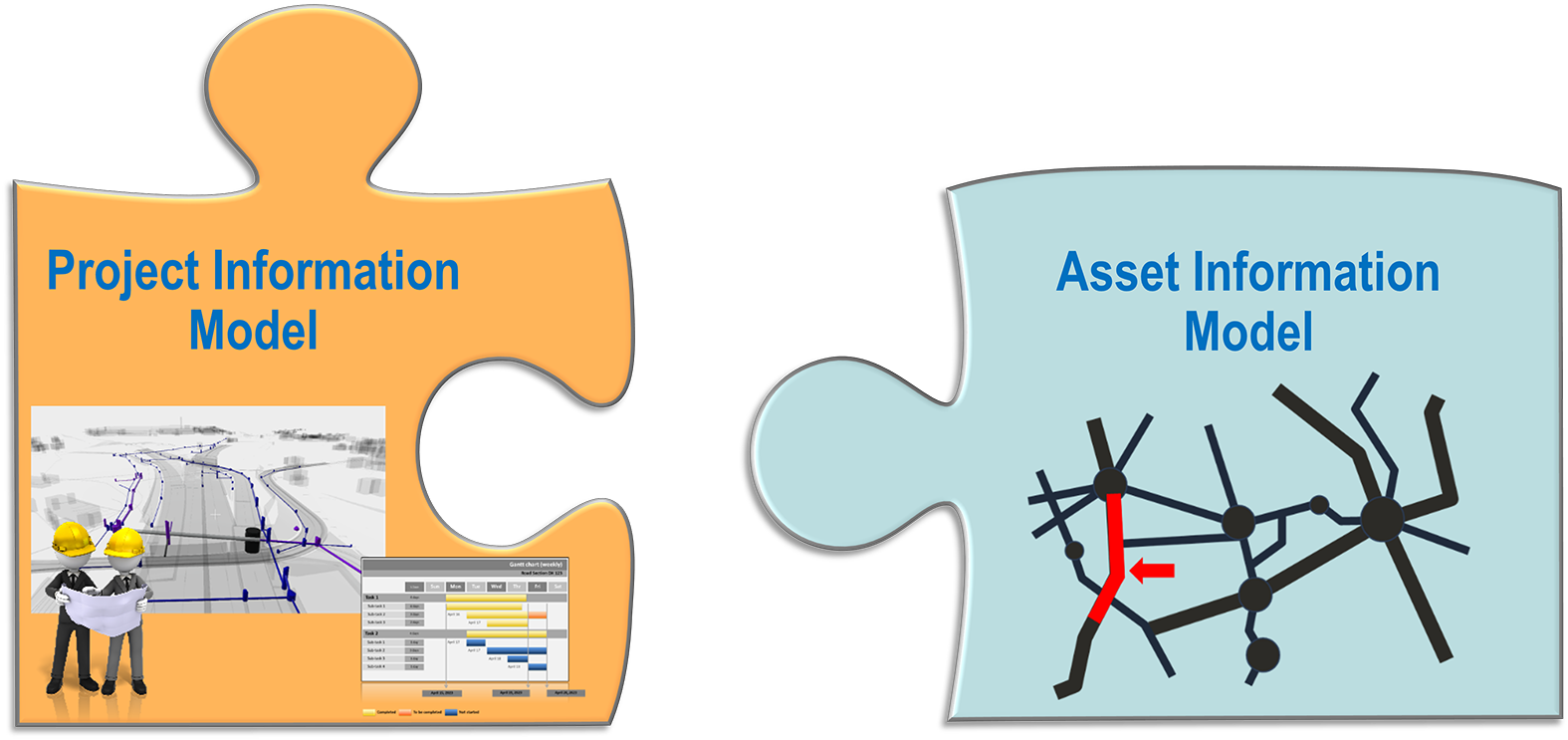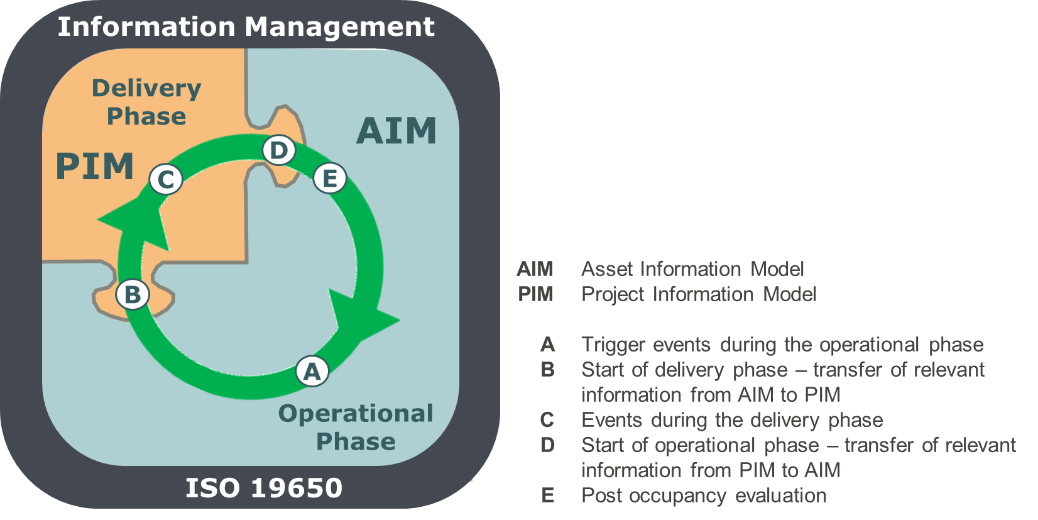

BIM defines two main phases in the life of any technical object: the delivery phase and the operation phase. The delivery phase includes planning, designing, construction of the new object, but also all other building activities in the lifecycle, such as maintenance and rehabilitation. The activities in the delivery phase are usually performed by appointed contractor(s). The delivery and operational phases interrelated in that an asset is design and commissioned, it then goes through a phase of maintenance and rehabilitation and at this end of its functional life, it may be reconstructed, then repeating the maintenance and rehabilitation.
BIM supports the road asset manager by providing the information models for both lifecycle phases, namely Project Information Model (PIM) for the delivery phase followed by Asset Information Model (AIM) for the operational phase (see Figure 4.3.4.1).

Figure 4.3.4.1 Interconnection between the network-oriented Asset Information Model and the measures-oriented Project Information Model
BIM according to ISO 19650 formulates uniform requirements for the information that is generated and managed in both lifecycle phases. These requirements are collected in a set of documents that support the asset manager (owner and operator) throughout the entire process of Asset Management. The two kinds of Information Models (AIM and PIM) and the documents containing the information requirements are the crucial pillars of BIM in the organization.
Figure 4.3.4.2 schematically shows the two main phases in the asset lifecycle with the corresponding information models and the most relevant trigger events (from "A" to "E").

Figure 4.3.4.2 Control loop of information and the relevant phases of the life cycle (based on ISO 19650-2 and ISO 19650-3 (ISO 2018))
The Asset Information Model covers the entire road network or asset portfolio under the jurisdiction of the respective road administration. The road database manages data and information to support ongoing operations as well as the planning of construction activities. As a rule, the road network model, the axis geometry, the cross-section elements, construction data, maintenance history, road equipment data, traffic data and, depending on their availability, other data such as bridges and tunnels, pavement and bridge condition data, images, accident reporting information, etc. are managed in this database. In addition to the standardized information in the road database, the Asset Information Model also includes other information, sometimes in distributed data sets or as "data containers" that may be integrated into decision-making processes as required.
The relevant tasks of the operator include the planning of routine operations (summer and winter operations) as well as planning construction and maintenance activities supported by Pavement Management Systems or network resilience analysis. The reporting on the inventory and condition of the entire network as well as the provision of relevant KPIs and other information for the owner and the general public are also based on the data from the Asset Information Model (see item "A" in Figure 4.3.4.2). These activities address the entire road network managed by the operator.
For pragmatic reasons, the Asset Information Model will not address the requirements for geometric accuracy (LOD) that are common in the planning and construction phases. In the operational phase, a focus on high LOD would be counterproductive because 3D models as applied to the delivery phase do not add value for many use cases, such as winter maintenance planning or prioritization of road sections for maintenance. The ISO 19650 standard emphasizes at several places that the Level of Model Definition (LOMD) must always correspond to the actual tasks and practical requirements.
Planning of maintenance and rehabilitation activities are regularly performed on the entire road network. It is in the operator's best interest that the changes of the as-built data resulting from the construction work are reflected in the Asset Information Model. One of the prerequisites for correctly updating the Asset Information Model partly already during or at the latest directly after the execution of the construction measure is providing the contractor with the current inventory data for the particular network element from the AIM (see item "B" in Figure 4.3.4.2).
Information management during the execution of construction activities is supported by the requirements outlined in the EIR (Exchange Information Requirements) and in the BIP (BIM Implementation Plan). The plan defines how the exchange of information between all parties will take place and how Common Data Environment will be developed.
The Project Information Model defined for the duration of the project determines both the data model (the digital twin of the construction object) and all data management processes. Effective information management and the exchange of information must be ensured (see item "C" in Figure 4.3.4.2). For larger projects with high realization costs and involvement of multiple parties, complex 3D data models will be applied. However, for small-scale projects, simple models are usually adequate.
Once construction activities are completed, the information is transferred from the Project Information Model to the Asset Information Model (see item "D" in Figure 4.3.4.2). The transfer is done in accordance with the requirements that are formulated in advance, during the needs assessment and documented as the Asset Information Requirements (AIR). Regardless of the scope and complexity of the specific project, it is relevant that all information about the completed project is coded according to the Asset Information Model standard. The information is transmitted either through the interface provided by the operator or through reconciled data services and controlled by the operator before the final update of the AIM (see item "E" in Figure 4.3.4.2). If the project has been implemented according to the highest level of BIM, it is recommended that the operator deliver the complete model (e.g. as an IFC model) in a data container and additionally extracts the data required by AIR from the PIM in the desired convention.
If all construction projects were performed according to the above-mentioned BIM requirements, a systematic update of the AIM and an increase in efficiency in the operational phase is achieved.